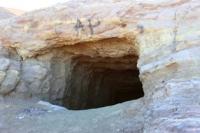You are here
Cave of Imankara.

Expedition tours in Kazakhstan.
“Nature is wise. You can learn everywhere and from everything ”
Leonardo da Vinci.
Traveling to tourist places of Atyrau region.
The cave of Imankara is located on the western slope of Mount Imankara in the east of the Atyrau region in the Zhalyoi region in the east of the Atyrau region. The cave is located at an altitude of 180 meters above sea level in a hilly area near the border with the Aktobe region, 6 kilometers from the highway to the village of Mukur.
The cave, hollowed out in sedimentary rocks of a dark color, does not look at all like a large-sized refuge. The cave is cut down with a slope in the depths of the mountain, the main trunk of the cave stretches for about 10 meters.
Then the main trunk of the cave branches into the right and left sleeve. The right sleeve of the cave stretches about 7 - 8 meters, the left sleeve is extended by 11 - 12 meters, in addition, the left sleeve has a branch to the left, a small room 2 x 1.5 meters.
Ceiling height of about 2 meters, possibly in places higher. On the walls of the cave are clearly visible traces of chopping tools, which cut down the cave. However, the first impression is misleading. Behind the small entrance is a whole network of rooms - corridors and branches with a total area of about one hundred square meters!
You can enter the cave only by bending down, but inside you can walk freely in full growth. Sometimes called the cave - the Nobel Cave. It is known that this Swedish entrepreneur in 1911 bought a concession for the development of the Emba oil fields. He looked for oil in these places.
Not far from the cave, even the skeleton of a small rig of that time was preserved. For what purpose the cave was cut down in the rocks containing bitumen, of course, we will never know, but as you can see, it was used as a natural warehouse-refrigerator and a resting place for drillers.
In the summer, in the vicinity of the cave, real hell. The internal configuration of the cave suggests that they did not seek to delve into the mountain. From the main tunnel, which stretches along the base of the mountain, several small rooms - cells were knocked out in the rock.
Nothing was said about the Nazi landing in our steppes in May 1944, many years later. For the first time about this Abwehr operation, more like an adventure, the general public became aware of the recollections of the NKVD veterans in the 70s-80s of the last century.
Then I read about this little-known page of the military past in one of the collections. ... soon a group of German paratroopers was surrounded by security officers. Reinforcements are being drawn from Guryev, Aktyubinsk, Dossor.
The Germans were invited to surrender. Instead of an answer, an automatic queue followed. Gaziz Kusainov, an operative in the Guryev Regional Directorate of the NKVD, kills an assault rifle with an aimed shot. At the next moment, one of the Aktobe residents threw a grenade and drowned the machine gun.
Shooting for a while subsided. But the saboteurs did not give up. They were surrounded by a dense ring and under a flurry of fire they all died. There were five of them, among them the traitor Agaev was identified.
Authority:
Miral Dzharmukhambetov (Aktobe Herald “The Last Lair of the Traitor”), Alexander Petrov, Yuri Pastukhov, “The Land of Snow-White History”, Atyrau, 2005.
Photos
Alexander Petrov.







